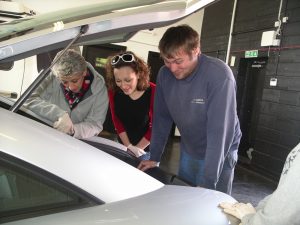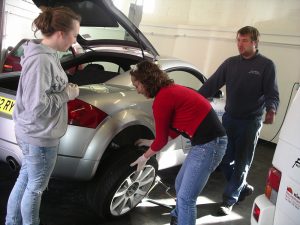We’ve just run our second Pit Stop Workshop so even more ladies in Essex are now self-sufficient in car maintenance. We asked one of our enthusiastic Pit Stoppers, Aisha Allan from Kelvedon, if she’d like to write about her experience; she said ‘yes’ so here’s her blog:
A pit stop workshop sounded about the last place I would choose to be on a Saturday morning. When I got the invite I must confess I wasn’t at all keen on starting my weekend in a garage, covered in grease and dirt. But when Paul told me there would be free tea and cake afterwards, well, it became an offer I just couldn’t refuse.
Greeted on that blustery morning by a warming cup of latte and smiling faces, I was looking forward to learning about car maintenance, because frankly, I didn’t know a lot – surely that’s what AA membership is for? But realising that if I got stuck on the side of the road with a flat tyre and a dead phone I’d still be able to do something about it, was convincing enough for me to give up a few hours of my time to learn.
I use my car every day to get to and from work, yet I found out I didn’t know a lot about it. We started with the basics. First, how to check tyre pressure and oil levels. This was easy enough, and after a few practice attempts I got the hang of it. The difficult part was changing a tyre.
Paul gave us lots of useful hints and tips along the way – don’t try to jack your car up on gravel, make sure it’s parked on level ground. And if you get a flat tyre when it’s raining, wait in the car for the AA to arrive (that’s one of my useful tips).

We got down and dirty changing the wheels, but a bit of audience participation was expected. Us girls had the opportunity to learn from the best, and have a laugh along the way.

I have to say I’m glad I spent my Saturday morning in a garage. The Pit Stop Workshop has given me piece of mind; now I know if I get stuck somewhere with a flat tyre I can deal with it myself. And for a girl like me to handle something like that and not have to call the AA, I would call a pretty big achievement.





